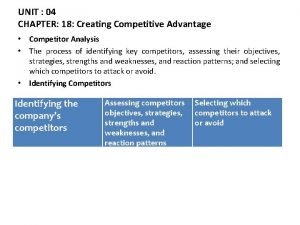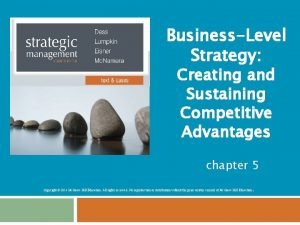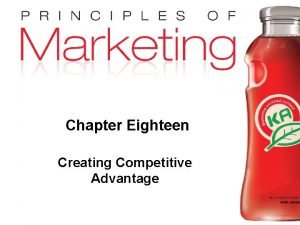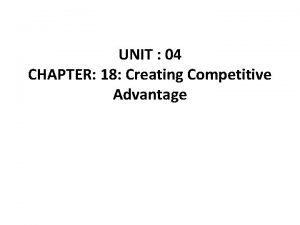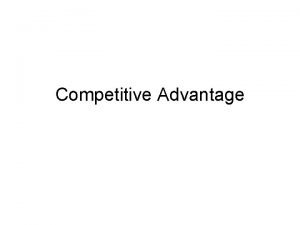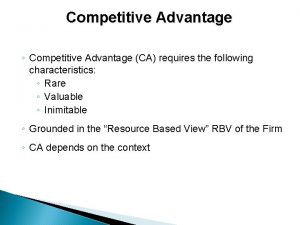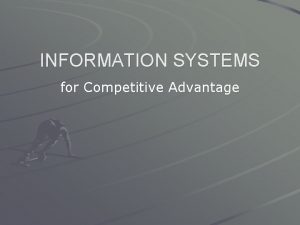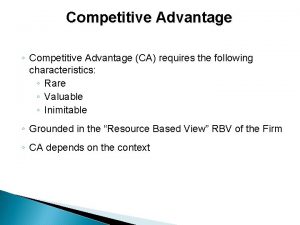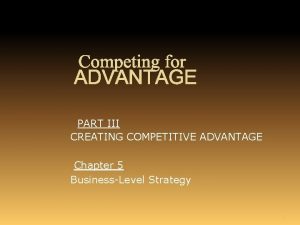Creating Competitive Advantage P Ghemawat J Rivkin Differences






- Slides: 6

Creating Competitive Advantage P. Ghemawat & J. Rivkin Differences in economic performance are common Understanding the root causes is crucial Part of the answer lies in differences in industry structure (Porter’s 5 forces) Contrasts in industry-level competitive forces are one reason that profit levels differ Some industries are just more attractive Industry-level effects represent about 10 -20% of profitability variance A successful firm does not simply participate in an attractive industry It also strives to generate more economic profits than the typical firm in the industry Part of the answer lies within the industry itself Within-industry effects account for 30 -45% of profitability variance Some firms have a competitive advantage over others and earn superior profits To create an advantage a firm must configure itself to do something unique & valuable Competitive advantage usually comes from a full range of a firm’s activities The essence of creating advantage is finding an integrated set of choices that distinguishes a firm from its rivals There are two basic ways a firm can establish an advantage: Raise customers’ willingness to pay without an equal or greater increase in opportunity cost Devise a way to reduce opportunity cost without sacrificing customers’ willingness to pay

Creating Competitive Advantage P. Ghemawat & J. Rivkin Cont’d. How does a firm identify opportunities to create competitive advantage Dumb (or smart) luck Entrepreneurial insight Analysis can hone insight Activities undertaken to: design, produce, sell, deliver and service products are what ultimately incur costs and generate customer willingness to pay Disparities between cost and willingness to pay (competitive advantage) comes from differences in what firms do day-to-day An analysis of activities usually proceeds in four steps

Creating Competitive Advantage P. Ghemawat & J. Rivkin Cont’d. Step 1. Catalogue Activities (The Value Chain) The value chain divides all activities into two classes: Primary Activities that directly generate a good or service Inbound logistics Operations Outbound logistics Marketing and sales After-sales service Support Activities that make the primary activities possible Procurement of inputs Development of technology Human resources General firm infrastructure Once activities have been catalogued, they must be analyzed in terms of cost and willingness to pay relative to the competition

Creating Competitive Advantage P. Ghemawat & J. Rivkin Cont’d. Step 2. Use Activities to Analyze Relative Costs Competitive cost analysis is the usual starting point Break down the major elements of the value chain into specific activities Calculate the costs associated with each class of activity Determine cost drivers associate with each activity Cost drivers are the factors that make the cost of an activity rise or fall e. g. delivery costs may be an activity identified in outbound logistics But what drives deliver costs up or down is the number of stops a truck has to make One large delivery costs a lot less than many small deliveries Cost drivers are critical because they allow managers to estimate competitors’ cost positions It is important to focus on differences in individual activities, not just differences in total cost Good cost analysis typically focus on a subset of all of a firm’s activities Differences in the resources possessed by a firm may also drive differences in activity costs e. g. being close to a source of cheap power

Creating Competitive Advantage P. Ghemawat & J. Rivkin Cont’d. Step 3. Use Activities to Analyze Relative Willingness to Pay The activities of a firm do not just generate costs They also increase customers’ willingness to pay for the firm’s products or services Any activity can affect customers’ willingness to pay Most obviously, product design and manufacturing activities that influence product characteristics: quality performance features aesthetics durability … affect willingness to pay more than other activities A firm can also boost willingness to pay through activities associated with sales or delivery post-sales service complementary goods signals conveyed through advertising, packaging and branding Support activities like hiring, training & compensation can have a surprisingly large, if indirect, impact on willingness to pay To get the most from this analysis segmentation may be necessary when customers differ in preferences

Creating Competitive Advantage P. Ghemawat & J. Rivkin Cont’d. Step 4. Explore Options and Make Choices When exploring options, the management team must work vigilantly to build a vision of the whole Competitive advantage comes from an integrated set of choices about activities A firm must usually consider changing many of its activities in unison in order to improve long-term prospects When considering changes in activities, it is crucial to consider competitors reactions

